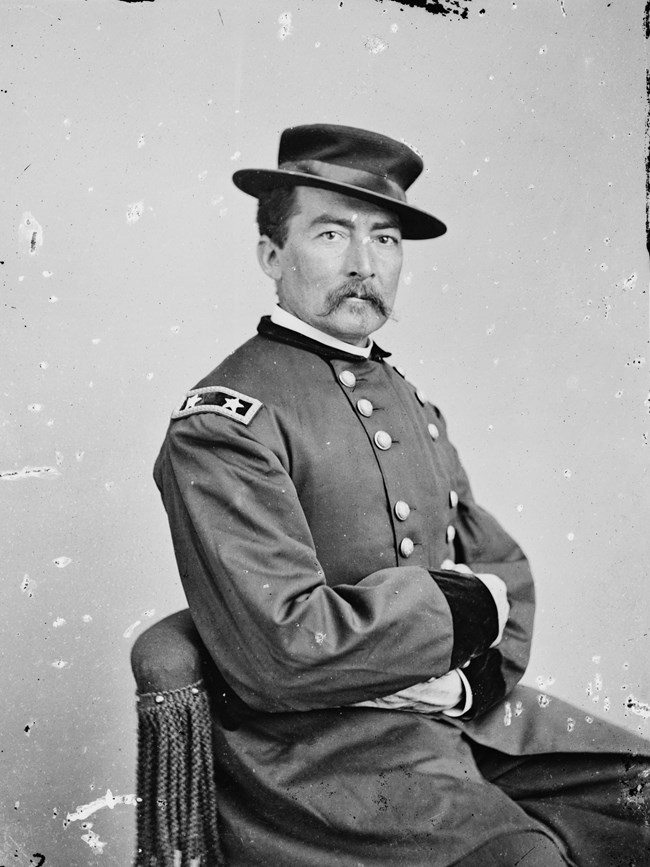Part of a series of articles titled Drive the Enemy South.
Article
Sheridan Takes Command of the Army of the Shenandoah

Library of Congress
US Gen. Philip Sheridan, as President Abraham Lincoln described him in 1864, had “a long body, short legs, not enough neck to hang him, and such long arms that if his ankles itch he can scratch them without stooping.”
Middle Military Department
Lincoln had just appointed Sheridan, 33 years old, to take command of the new Middle Military Department, a consolidation of the armies around Washington, DC and in the Shenandoah Valley. Confederate Gen. Jubal Early’s raid into Maryland in July 1864 exposed the armies’ weakness in responding to Confederate operations in the Shenandoah Valley.
Gen. Ulysses S. Grant, commander of all the US armies initially suggested other generals for the job. Lincoln rejected each for one reason or another. Lincoln was also cool at first to the idea of Sheridan, who he thought him too young and inexperienced.
On his way to take command of the new department, Sheridan met in Washington, D.C., with Lincoln and Secretary of War Edwin Stanton. Both had reservations about whether Sheridan could handle the job. Lincoln masked those feelings, but he ended their meeting by saying he “hoped for the best.”
Afterwards, as Stanton and Sheridan walked to the War Department, Stanton stressed the “necessity for the success from the political as well as from the military point of view.” Sheridan understood that meant Lincoln’s re-election in November depended upon winning battles. Grant emphasized that expectation on August 6 when he met Sheridan at Monocacy Junction. In addition to defeating Early’s Confederate forces in the Shenandoah Valley, Grant instructed Sheridan to destroy the Valley’s resources, turning it into a “barren waste.”
Army of the Shenandoah
In August 1864 Sheridan took over his new department, which he called the Army of the Shenandoah. Of about 50,000 troops under his command, nearly 10,000 would be used to guard the Baltimore & Ohio Railroad. He based his operations in Harpers Ferry, West Virginia.
Making up Sheridan’s field army would be the 6th Corps, from the Army of the Potomac; the 19th Corps, from the Department of the Gulf; the 8th Corps, also called the Army of West Virginia; and three divisions of cavalry, two of which would come from the Army of the Potomac. Once all of those units had joined Sheridan, he could count on just under 40,000 troops in the field.
On August 10, 1864, Sheridan started his army south to swing down south of Winchester,, Gen. Alfred Torbert’s cavalry leading the way. Sheridan hoped to cut off Early’s Army of the Valley, then positioned south of Martinsburg, West Virginia.
Once he learned that Sheridan was moving, Early consolidated his troops around Winchester. Sheridan nearly succeeded in blocking their retreat route south, but Early held control of the Valley Pike. By August 13 the Confederates had withdrawn south to Fisher’s Hill.
By that time, Sheridan’s army was in the area of Strasburg, Virginia, some three miles north of Fisher’s Hill. It was there that Sheridan heard that Confederate reinforcements were approaching.
Gen. Robert E. Lee had decided to send Gen. Joseph Kershaw’s infantry division, Gen. Fitzhugh Lee’s cavalry division, and Major Wilfred Cutshaw’s artillery battalion, all under the command of Gen. Richard Anderson. Those 6,100 Confederate soldiers would bring Early’s strength to nearly 21,000, and with the Federal high command over-estimating Early’s numbers, Sheridan was concerned that his 26,000 would be too few to take on Early.
Signal Knob
While at Strasburg, Sheridan became increasingly annoyed with the Confederate signal station at Signal Knob, on Massanutten Mountain. “Every daylight movement of our troops could be seen by the enemy,” he wrote later, “better than if they were in our camps.” To dislodge and hold Signal Knob, Sheridan ordered Gen. George Crook to send some of his Army of West Virginia men up the mountain.
On August 14, 1864, members of the 12th West Virginia climbed up Massanutten, drove off the few Confederates defending the signal station, but several hours later, a larger Southern force returned and took it back.
The next morning the Federals tried it again, this time sending up two regiments – the 14th West Virginia, with the 116th Ohio in support – to accomplish the task. “The underbrush was so dense that it was with great difficulty a man could get through,” one Federal recalled. More Confederates were defending the station now, so the fighting intensified and lasted much of the day, but in the end, the Federals were ordered to pull back.
Sheridan had just received a message from Grant, with additional information on the Confederate force sent to reinforce Early. In his message, Grant advised Sheridan to “be cautious and act on the defensive,” until Federal offensive efforts around Richmond and Petersburg compelled Lee to recall those reinforcements.
Sheridan felt he now had explicit orders to retreat north, and then wait until Early had to send troops back to Lee.
Last updated: December 1, 2022
